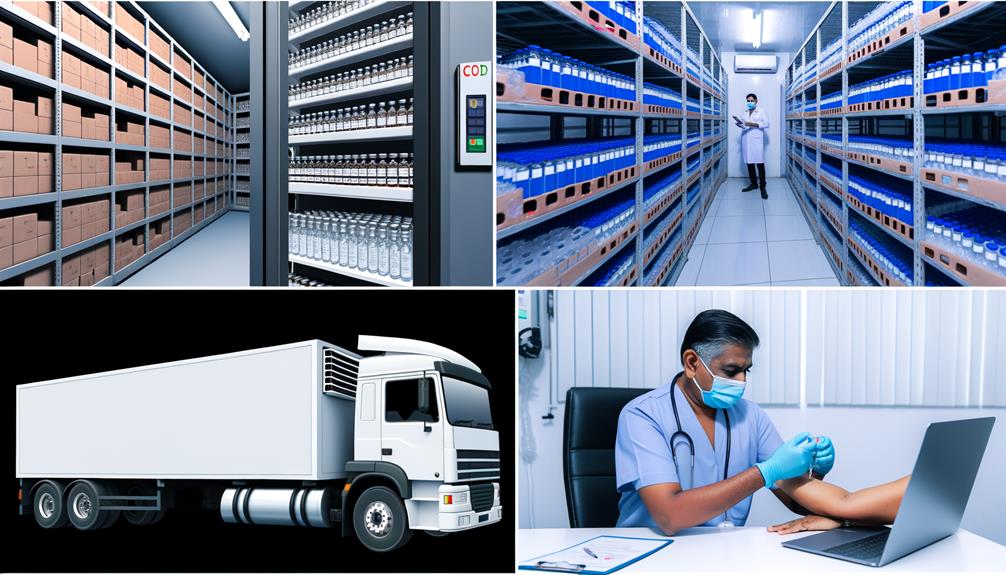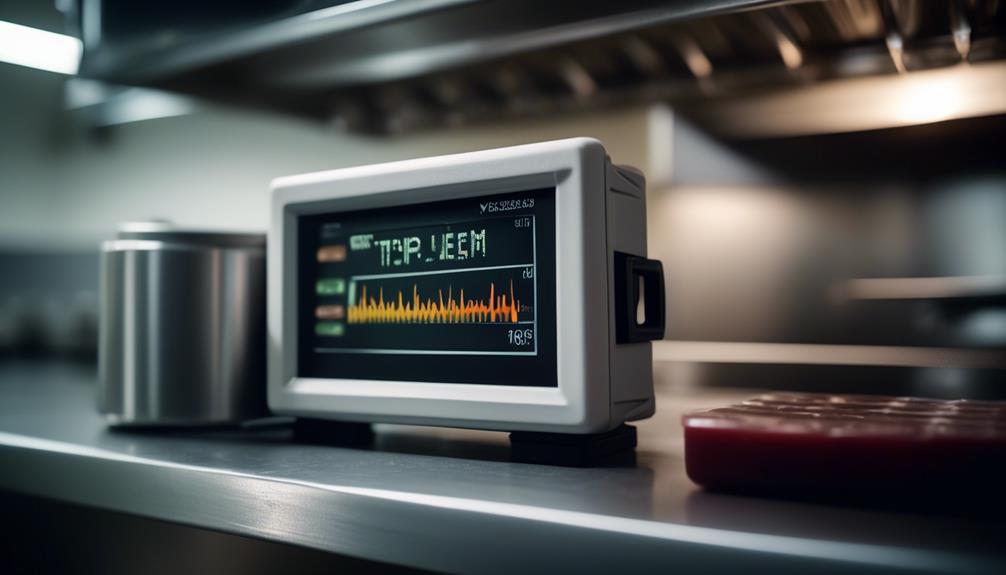Imagine a scenario where a community is eagerly awaiting the arrival of a highly anticipated vaccine. However, upon delivery, it is discovered that the vaccine’s potency has been compromised due to improper temperature control during transportation.
This is just one example of how crucial cold chain management is in the distribution of vaccines. Without proper temperature control, the efficacy of vaccines can be greatly diminished, leading to potential public health risks.
Understanding the intricacies of cold chain management is essential in ensuring that vaccines reach their intended recipients in optimal condition.
Importance of Temperature Control
Maintaining proper temperature control throughout the vaccine distribution process is crucial to ensuring the efficacy and safety of the vaccines. When vaccines are exposed to temperatures outside of the recommended range, their potency and effectiveness can be compromised. For instance, if a vaccine that requires refrigeration is exposed to higher temperatures, it can become ineffective, leading to potential health risks for individuals who receive it. On the other hand, if a vaccine that should be kept frozen is exposed to warmer temperatures, it can degrade and lose its ability to provide immunity.
To prevent such issues, it’s essential to use temperature-monitoring devices and follow strict protocols for storage and transportation. These measures help to maintain the integrity of the vaccines and ensure that they remain viable until they reach their intended recipients.
Key Components of Cold Chain
To ensure the efficacy and safety of vaccines during distribution, understanding the key components of the cold chain is essential.
The cold chain consists of crucial components that work together to maintain the required temperature range for vaccines from the point of manufacture to the administration to patients.
The key components include refrigerators, freezers, cold boxes, and temperature-monitoring devices. Refrigerators are essential for storing vaccines at temperatures between 2°C and 8°C, while freezers are necessary for storing vaccines that require ultra-low temperatures.
Cold boxes are used for transporting vaccines, especially to remote areas, while temperature-monitoring devices such as data loggers ensure that the vaccines remain within the required temperature range throughout the distribution process.
Furthermore, the cold chain also involves trained personnel who understand the importance of temperature control and proper handling procedures. These individuals play a critical role in ensuring that the vaccines remain potent and effective.
Understanding and effectively managing these key components are vital in safeguarding the quality of vaccines as they make their way to the individuals who need them.
Challenges in Cold Chain Management
When managing the cold chain, it’s crucial to navigate through various logistical and environmental obstacles to ensure the integrity of vaccine storage and distribution.
One of the primary challenges is maintaining the required temperature range from the point of manufacture to the administration site. Temperature excursions during transportation or storage can compromise the potency of vaccines, rendering them ineffective.
Additionally, the lack of reliable power sources in some regions can lead to difficulties in maintaining the cold chain, especially in remote areas.
Another challenge is the limited visibility and tracking of vaccine shipments, which can lead to delays in identifying and responding to temperature deviations or other issues.
Furthermore, inadequate infrastructure and resources for proper cold chain management in certain areas pose significant hurdles.
These challenges demand proactive solutions, such as implementing robust monitoring systems, improving infrastructure, and providing training to personnel involved in cold chain management.
Overcoming these obstacles is vital to ensure the efficacy of vaccines and the success of immunization programs worldwide.
Strategies for Maintaining Cold Chain
To ensure the success of cold chain management, it’s essential to implement proactive strategies that address potential logistical and environmental challenges in vaccine distribution.
Firstly, prioritize regular training for all personnel involved in the cold chain process. This ensures that everyone understands the importance of maintaining the cold chain and knows how to handle any unforeseen circumstances.
Additionally, employing robust monitoring systems is crucial. Real-time temperature monitoring, GPS tracking, and alarms for temperature deviations can help identify and address issues promptly.
Furthermore, optimizing packaging is vital. Utilize insulated containers, phase change materials, and temperature-monitoring labels to maintain the integrity of vaccines during transportation.
Moreover, establishing strong partnerships with reliable transportation providers is key. Work with carriers who understand the sensitivity of vaccine shipments and have a proven track record in cold chain logistics.
Finally, develop contingency plans for potential disruptions. Identify alternative storage facilities, transportation routes, and quick response protocols in case of emergencies.
Impact on Vaccine Efficacy
Maintaining the cold chain throughout the vaccine distribution process is critical for ensuring the maximum efficacy of the vaccines. Any deviation from the recommended temperature range can significantly impact the potency of the vaccines. When exposed to temperatures outside the recommended range, vaccines can lose their effectiveness, rendering them less able to provide the necessary immune response. This can lead to an increased risk of vaccine-preventable diseases spreading within the population. Moreover, compromised vaccine efficacy can undermine public trust in vaccination programs and jeopardize the overall success of disease prevention efforts.
Proper cold chain management is particularly crucial for vaccines that are sensitive to temperature fluctuations, such as the mRNA COVID-19 vaccines. These vaccines require ultra-low temperatures for storage and transportation to maintain their stability and effectiveness. Without adherence to the cold chain requirements, these vaccines may lose their potency, ultimately impacting their ability to confer immunity against the virus.
In essence, the impact of inadequate cold chain management on vaccine efficacy can’t be overstated. It underscores the critical need for meticulous temperature control at every stage of the vaccine distribution process to ensure that vaccines retain their full effectiveness and contribute to effective disease prevention.
Frequently Asked Questions
How Does Cold Chain Management Impact the Distribution of Vaccines in Remote or Hard-To-Reach Areas?
In remote or hard-to-reach areas, cold chain management ensures vaccines remain potent by maintaining proper temperature control. This impacts distribution by guaranteeing the effectiveness of vaccines, ultimately improving immunization coverage in these challenging locations.
What Are the Specific Regulatory Requirements and Guidelines for Cold Chain Management in Different Countries?
You should research specific regulatory requirements and guidelines for cold chain management in different countries. It’s important to understand the unique regulations and standards to ensure compliant and effective vaccine distribution in various global regions.
How Do Cold Chain Management Strategies Differ for Different Types of Vaccines (E.G. Live Attenuated, Inactivated, Subunit, Etc.)?
When managing cold chain for different vaccines, consider their specific requirements. Live attenuated vaccines need strict temperature control, while inactivated vaccines are more stable. Subunit vaccines may require specific storage conditions, so tailor your strategy accordingly.
What Are the Potential Risks and Consequences of a Breakdown in the Cold Chain During Vaccine Distribution?
If the cold chain breaks during vaccine distribution, potential risks include reduced vaccine efficacy, increased potential for infections, and wasted resources. Consequences may include outbreaks, loss of public trust, and economic burden.
How Are Advancements in Technology and Innovation Impacting Cold Chain Management for Vaccine Distribution?
Advancements in technology and innovation are revolutionizing cold chain management for vaccine distribution. New methods like IoT sensors and improved packaging are enhancing monitoring and ensuring vaccines remain effective and safe during transportation.
Conclusion
In conclusion, maintaining a proper cold chain is crucial for ensuring the efficacy of vaccine distribution.
By controlling the temperature and handling of vaccines throughout the supply chain, we can ensure that vaccines remain effective and safe for administration.
It’s important to address the challenges in cold chain management and implement strategies to maintain the integrity of the vaccines, ultimately impacting the success of vaccination programs worldwide.



